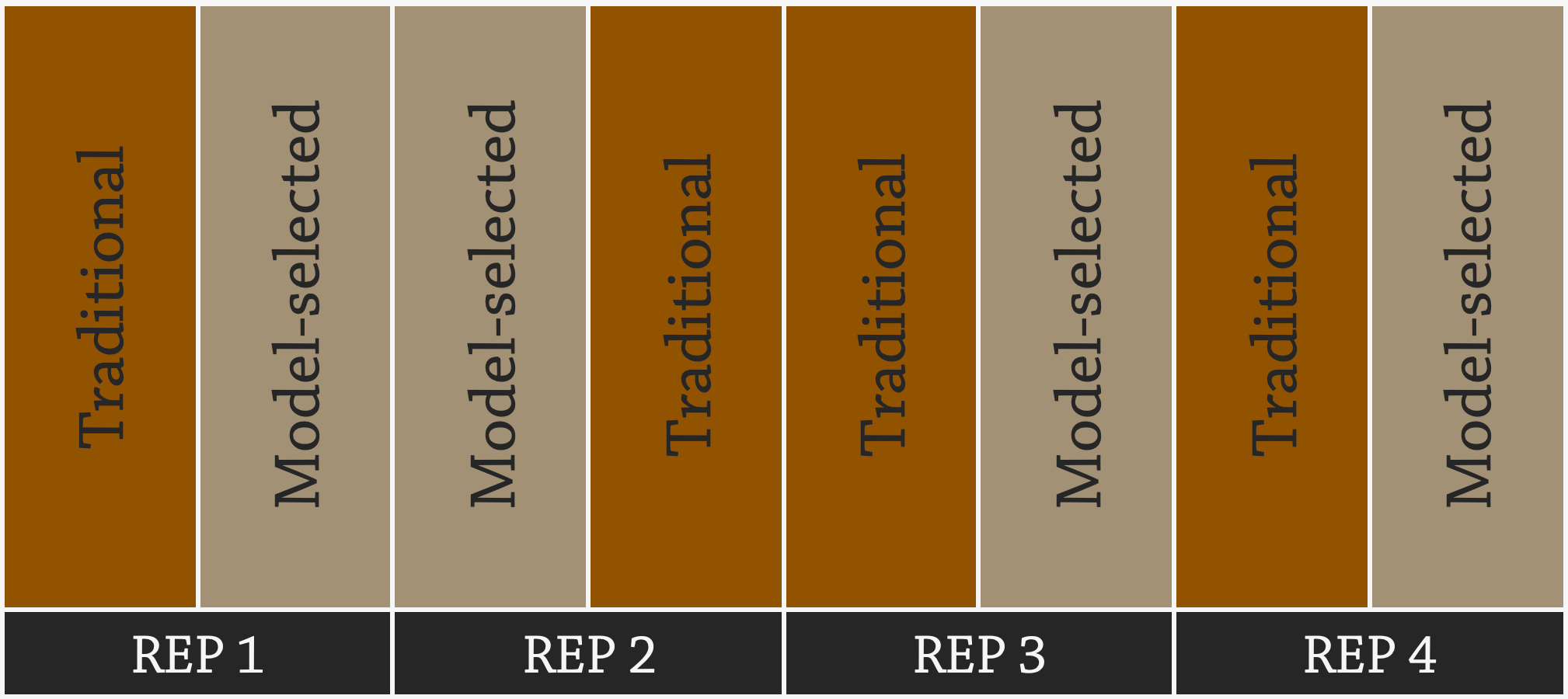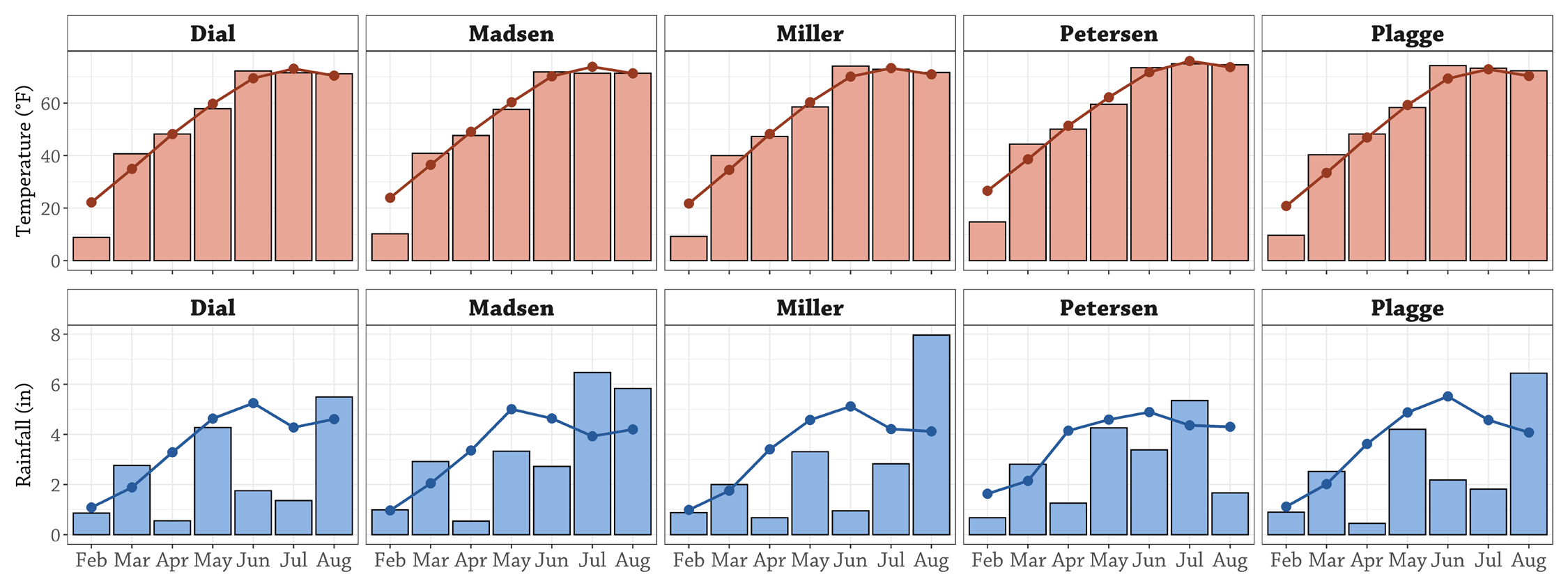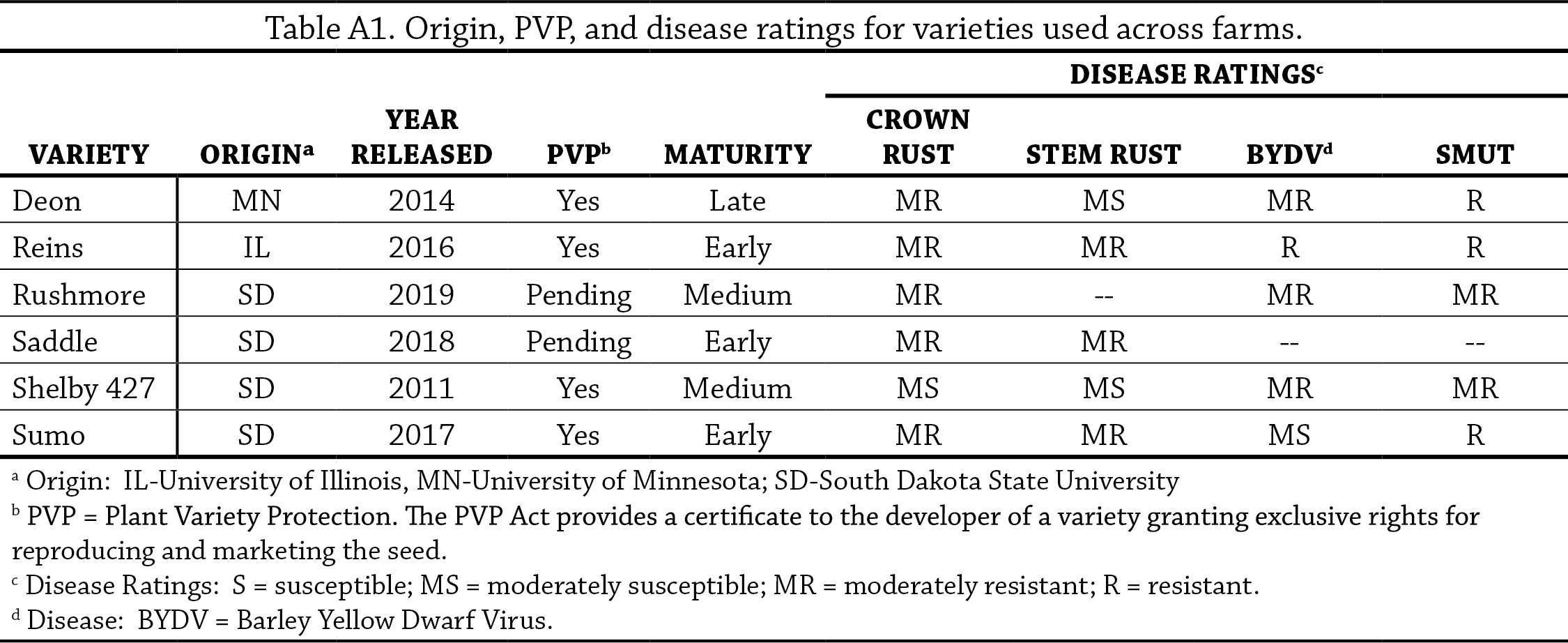This research was funded by SARE and Walton Family Foundation.
In a Nutshell:
- Variety selection is a key component of growing high quality oats, but information about which varieties are best suited to perform in a particular site is often lacking due to the limited scope of variety trial locations.
- This was the second year cooperators compared the performance of their traditional oat variety with a variety predicted to do well from a genotype-by-environment model.
Key Findings:
- Across all five farms, the traditional oat variety either outperformed or equaled the model-selected variety in both yield and test weight.
- At two farms, Dial and Plagge, the traditional oat variety (Reins in both cases) had a higher yield than the model-selected variety, while at the other three farms there was no difference in yield.
- At two farms, Miller and Plagge, the traditional oat variety, had a higher test weight than the model-selected variety, while at the other three farms there was no difference in test weight.
- Four of the five farms chose Reins as their traditional variety.
- Coming up with models that can reliably estimate variety performance across farm locations is challenging and requires a combination of historical data, predictions and on-the-ground calibration. These results indicate that our current models predicting oat variety selection can continue to be refined.
Background
Variety selection is an important consideration for growing high quality oats. Oats are bred for numerous traits including disease resistance, maturity, height, yield and lodging. Oats are grown for various end uses, including food grade milling, cover crop seed, livestock feed (either as grain, hay, or oatlage), straw bedding or as a nurse crop for alfalfa. Matching the variety characteristics with the end market is an important step for successful production. For instance, farmers looking to sell oats into a food-grade market should select a variety that has high test weight, because the grain must reach a certain heft to avoid dockage.
To examine oat variety performance across Iowa, PFI has conducted variety trials every year since 2015. Occasionally one variety will perform the best, in terms of yield, across all trial locations.[1-2] But more commonly the top yielding variety differs across sites.[3-7] That fact that some varieties perform well in certain locations but not in other locations is called a genotype-by-environment interaction and it is commonplace in plant breeding, especially among small grains.
The best way to get reliable variety performance given genotype-by-environment interactions is to set up hyper-localized variety trials. Usually, however, that is not feasible. So instead, PFI, in conjunction with plant breeders, has been working since 2018 on developing models to predict small grain performance in localized environments. These genotype-by-environment models power a decision tool that takes into account existing small grains variety data and uses that information to predict performance of varieties based on a grower’s ZIP code.
In 2020 trials testing the accuracy of this model-drive decision tool, the model only correctly predicted performance of yield and test weight at certain sites and not others.[8] In other words, the results were a mixed bag. Given that information, researchers tweaked how the model was run in 2021 with the hopes that it would yield more accurate predictions. To test this model for a second year, five cooperators conducted a trial comparing the oat variety they would typically use (“traditional” variety) alongside a variety predicted to perform well in the model (“model-selected” variety).
Methods
In 2021, the genotype-by-environment models predicted performance of varieties based on both yield and test weight. All farmers selected from the models a variety that was predicted to outperform their traditional variety for yield, test weight or both (Table 1). Each farm compared two varieties except for Miller, who compared three varieties – two traditional and one model-selected. All farms planted their traditional variety(s) alongside a model-selected variety in randomized replicated strip trials (Figure A1). Information about each variety used in these trials can be found in the Appendix (Table A1). The oat production practices for each farm can be found in Table 1.
Weight and moisture of each strip replicate were collected by the farmer at each site and samples of grain from each strip replicate were mailed to the University of Wisconsin-Madison where they were analyzed for test weight.
Data analysis
Data were analyzed in R version 4.0.2.[9] An ANOVA comparing varieties was run for each farm, for both yield and test weight. Means separations are reported using Tukey’s Least Significant Difference (LSD) determined at the 95% confidence level.
Results and Discussion
Yield
Yields ranged from 70 to 162 bu/ac across sites (Figure 1). Madsen and Plagge had the highest yields overall, but they were the only sites that applied any fertilizer to their oats (Table 1). Two farms, Dial and Plagge, saw statistically significant differences in yields between varieties, and in both cases the traditional variety, Reins, outperformed the model-selected variety. Rushmore, the traditional variety, appeared to out-yield Sumo at Madsen’s farm, but variation across replicates meant that this relationship was not statistically significant and therefore could not be confidently predicted to occur again. Neither Miller or Petersen, whose model-selected varieties were predicted to out-yield the traditional varieties, saw any statistical differences in yields (Figure 1).

FIGURE 1. Yield comparisons between farmer-chosen oat varieties (traditional) and the variety predicted to do well by the model (model-selected). Bar height represents average yield, while dots represent the yield from individual replicates. Within each site, letters indicate whether differences in yield were greater than the least significant difference (LSD) at the 95% confidence level, meaning we’re 95% certain we’d expect to see that difference again if the experiment were repeated.
Test weight
Test weight ranged from 33.0 to 40.6 lb/bu across farms. Even with the hot, dry season most farms had both varieties meet the threshold for food grade milling – 38 lb/bu (Figure 2). Once again at the Plagge farm, the traditional variety, Reins, outperformed the model-selected variety, Rushmore. Miller also saw statistically significant differences in test weight between varieties, with Shelby427 having a higher test weight than Saddle. Neither Dial or Madsen, who chose Sumo as their model-selected variety given its favorable test weight predictions, saw a difference between the test weight of their varieties (Figure 2).

FIGURE 2. Test weight comparisons between farm-chosen oat varieties (traditional) and the variety predicted to do well by the model (model-selected). Bar height represents average test weight, while dots represent the test weight from individual replicates. Within each site, letters indicate whether differences in test weight were greater than the least significant difference (LSD) at the 95% confidence level, meaning we’re 95% certain we’d expect to see that difference again if the experiment were repeated. The dashed line at 38 lb/bu indicates the “gold standard” of test weight. Anything over a 38 lb/bu test weight is eligible for food grade milling without price dockage.
Conclusions and Next Steps
Once again, these results underscore the need to ground-truth models as they are deployed, given that none of the model selected varieties significantly outperformed the traditional varieties for either yield or test weight. In 2021, four of the five farmers grew Reins as their traditional variety and overall it performed well compared to the other four varieties tested, underscoring farmer’s choice to continue to use it.
These on-farm trials provide valuable information that will refine efforts to leverage small grain variety information into models that can assist farmers in decision making.
Appendix – Trial Design and Weather Conditions

FIGURE A1. Sample experimental design used by the cooperators. Each farm had 4 replicates of their traditional variety and the variety predicted by the model. This design allows for statistical analysis of the results.

FIGURE A2. Monthly average temperature (top) and total rainfall (bottom) for February – August. Bars represent the 2021 growing year, while lines represent long term averages (1950-2020) for each site. Data taken from the nearest weather stations to each farm: Dial – Webster City, Madsen – Audubon, Miller – Allison, Plagge – Hampton, Petersen – Knoxville. Click to enlarge.
References
- Gailans, S., S. Carlson, M. Schnabel K. Pecinovsky, and W. Koehler. 2019. Oat Variety Trials 2019. Practical Farmers of Iowa Cooperators’ Program https://practicalfarmers.org/research/oat-variety-trial-2019/ (accessed November 2021)
- Gailans, S., L. English, M. Schnabel, K. Pecinovsky. 2020. Oat Variety Trial 2020. Practical Farmers of Iowa Cooperators’ Program https://practicalfarmers.org/research/oat-variety-trial-2020/ (accessed November 2021)
- Gailans, S., L. English, M. Schnabel, K. Pecinovsky. 2021. Oat Variety Trial 2021. Practical Farmers of Iowa Cooperators’ Program https://practicalfarmers.org/research/oat-variety-trial-2021/ (accessed November 2021)
- Gailans, S., S. Carlson, M. Schnabel, K. Pecinovsky and W. Johnson. 2018. Oat Variety Trial 2018. Practical Farmers of Iowa Cooperators’ Program. https://practicalfarmers.org/research/oat-variety-trial-2018/ (accessed November 2021)
- Gailans, S., S. Carlson, M. Schnabel, K. Pecinovsky, B. Lang, and W. Koehler. 2017. Oat variety and fungicide trials 2017. Practical Farmers of Iowa Cooperators’ Program. Ames, IA. https://practicalfarmers.org/research/oat-variety-and-fungicide-trials-2017/ (accessed Jan. 17, 2019). (accessed November 2021)
- Gailans, S., S. Carlson, M. Schnabel, K. Pecinovsky, B. Lang, and W. Johnson. 2016. Oat variety trials 2016. Practical Farmers of Iowa Cooperators’ Program. Ames, IA. http://practicalfarmers.org/farmer-knowledge/research-reports/2016/oat-variety-trials-2016/ (accessed November 2021)
- Gailans, S., S. Carlson, K. Pecinovsky and B. Lang. 2015. Oat variety and fungicide trials. Practical Farmers of Iowa Cooperators’ Program. Ames, IA. http://practicalfarmers.org/farmer-knowledge/research-reports/2015/oat-variety-and-fungicide-trials/ (accessed November 2021)
- English, L. D. Fehr, C. Ingels, R. Rosmann, T. Thompson, and S. Wedemeier. 2020. Oat Selector Tool Variety Trial. https://practicalfarmers.org/research/oat-selector-tool-variety-trial/ (accessed November 2021)
- R Core Team (2020). R: A language and environment for statistical computing. R Foundation for Statistical Computing, Vienna, Austria. URL https://www.R-project.org/




